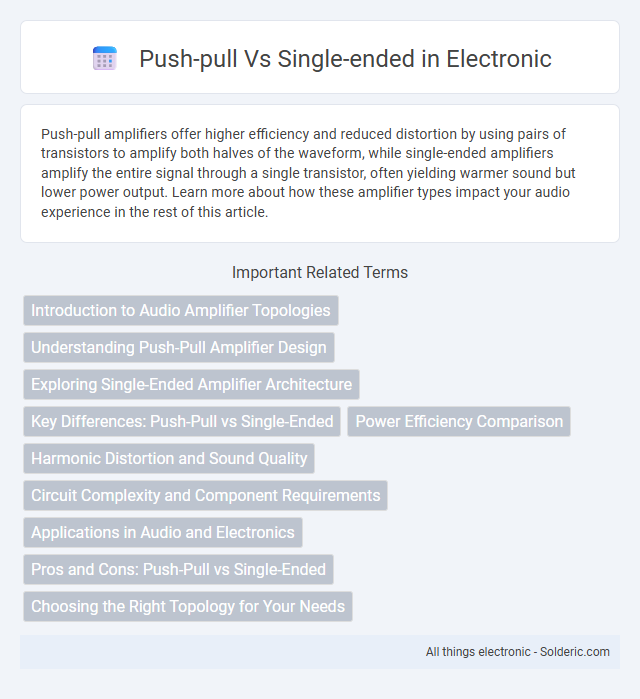Push-pull amplifiers offer higher efficiency and reduced distortion by using pairs of transistors to amplify both halves of the waveform, while single-ended amplifiers amplify the entire signal through a single transistor, often yielding warmer sound but lower power output. Learn more about how these amplifier types impact your audio experience in the rest of this article.
Comparison Table
| Feature | Push-Pull | Single-Ended |
|---|---|---|
| Signal Type | Balanced differential signal | Unbalanced signal referenced to ground |
| Noise Immunity | High - rejects common-mode noise | Low - susceptible to noise |
| Power Efficiency | Higher - both transistors conduct alternately | Lower - single transistor active per signal phase |
| Output Swing | Full rail-to-rail voltage swing | Limited by single transistor saturation |
| Complexity | More complex circuit design | Simple and easy to implement |
| Applications | High-speed digital circuits, RF amplifiers | Audio electronics, simple signal amplification |
| Distortion | Lower distortion with balanced load | Higher distortion due to single-ended operation |
Introduction to Audio Amplifier Topologies
Push-pull and single-ended amplifier topologies offer distinct approaches to audio amplification, each impacting sound quality and efficiency differently. Push-pull designs use pairs of active devices to drive the output, providing higher power and reduced distortion, while single-ended amplifiers rely on a single active device, delivering a warmer, more linear sound with increased harmonic richness. Understanding these audio amplifier topologies helps you select the ideal solution for your audio system's performance and tonal preferences.
Understanding Push-Pull Amplifier Design
Push-pull amplifier design employs two transistors or tubes working in opposite phases to deliver higher power output with reduced distortion compared to single-ended amplifiers. This configuration cancels even-order harmonics, improving signal clarity and efficiency in audio amplification. Single-ended designs, while simpler and often preferred for their warm sound, typically produce higher distortion and lower power efficiency than push-pull counterparts.
Exploring Single-Ended Amplifier Architecture
Single-ended amplifier architecture relies on a single active device to amplify the input signal, offering simplicity and cost-effectiveness compared to push-pull designs. This configuration typically produces higher distortion and lower efficiency but excels in applications that require minimal circuitry and straightforward implementation. Your choice of amplifier design should consider single-ended architecture for projects where simplicity and sound character are prioritized over power efficiency.
Key Differences: Push-Pull vs Single-Ended
Push-pull amplifiers use two active devices that alternately drive the load, providing better efficiency, higher output power, and reduced even-order harmonic distortion compared to single-ended amplifiers. Single-ended amplifiers operate with a single active device conducting throughout the entire signal cycle, resulting in simpler design but increased distortion and lower power efficiency. Push-pull configurations are preferred in high-fidelity and power applications, while single-ended stages are common in low-power, audio, and RF applications where linearity and simplicity are prioritized.
Power Efficiency Comparison
Push-pull amplifiers deliver higher power efficiency due to their complementary transistor operation that reduces distortion and maximizes output swing, often achieving efficiencies around 70-80% in class B or AB configurations. Single-ended amplifiers typically exhibit lower power efficiency, usually below 50%, because they conduct current continuously through a single active device, resulting in greater power dissipation as heat. The improved thermal management and reduced power loss in push-pull designs make them preferable for high-power audio and RF applications where energy efficiency is critical.
Harmonic Distortion and Sound Quality
Push-pull amplifiers typically exhibit lower harmonic distortion compared to single-ended designs, resulting in cleaner and more accurate sound reproduction. Single-ended amplifiers often introduce even-order harmonic distortion, which can add warmth and character but may compromise precision and clarity. Your choice between the two should consider whether you prioritize musicality with harmonic colorations or a more neutral and detailed sound profile.
Circuit Complexity and Component Requirements
Push-pull circuits involve complementary pairs of transistors that work together to amplify both halves of a waveform, resulting in increased circuit complexity and a higher number of components compared to single-ended designs. Single-ended circuits utilize a single active device to handle the entire signal, simplifying the design and reducing component count, which makes them more straightforward but potentially less efficient in terms of distortion and power handling. Your choice between push-pull and single-ended configurations will depend on balancing complexity, component availability, and performance requirements.
Applications in Audio and Electronics
Push-pull amplifiers excel in audio applications by reducing even-order harmonic distortion, offering cleaner sound reproduction for high-fidelity systems and guitar amplifiers. Single-ended circuits are favored in low-power audio devices and tube amplifiers for their simplicity and characteristic warm, harmonic-rich output. Your choice between push-pull and single-ended configurations affects audio quality, efficiency, and circuit complexity in electronics design.
Pros and Cons: Push-Pull vs Single-Ended
Push-pull amplifiers offer higher efficiency and better linearity by using two active devices that drive opposite phases, resulting in reduced distortion and improved power output. Single-ended amplifiers produce a warmer, more harmonically rich sound but suffer from lower efficiency and higher distortion due to a single active device handling the entire waveform. Your choice depends on whether you prioritize efficiency and clarity (push-pull) or simplicity and tonal character (single-ended).
Choosing the Right Topology for Your Needs
Push-pull amplifiers offer higher efficiency and lower distortion, making them ideal for applications requiring balanced output and power handling, while single-ended amplifiers provide simplicity and better linearity suited for low-power or audio fidelity uses. Your choice depends on factors like output power, harmonic distortion tolerance, and circuit complexity. Evaluating these parameters ensures the selected topology aligns perfectly with your performance and design requirements.
Push-pull vs Single-ended Infographic

 solderic.com
solderic.com